Hornung and The Kid
Take a Knee, Paul
The seed of the seed was planted by Dan Mabey. His three books covering Post cereal’s United States based baseball card promotions that ran from 1961-63 provided a lot of information that correlated to production of the 1962 football card campaign—my primary collecting interest. I’d contacted Dan via e-mail about some subjects in the books and in one of his replies, he asked if I knew who photographed the players for the football cards. I’d never thought about even trying to find out—that was well beyond where I was at in those days. But the seed was in the ground and sooner or later it either had to return to dust or spring forth.
The story of finding Post cereal football’s photographer, Jim Laughead, is documented on other pages on this website. One key to finding Laughead was a postcard of Green Bay Picture Day, the picture having been taken at the 1961 Packers photo shoot by Hank Lefebvre.
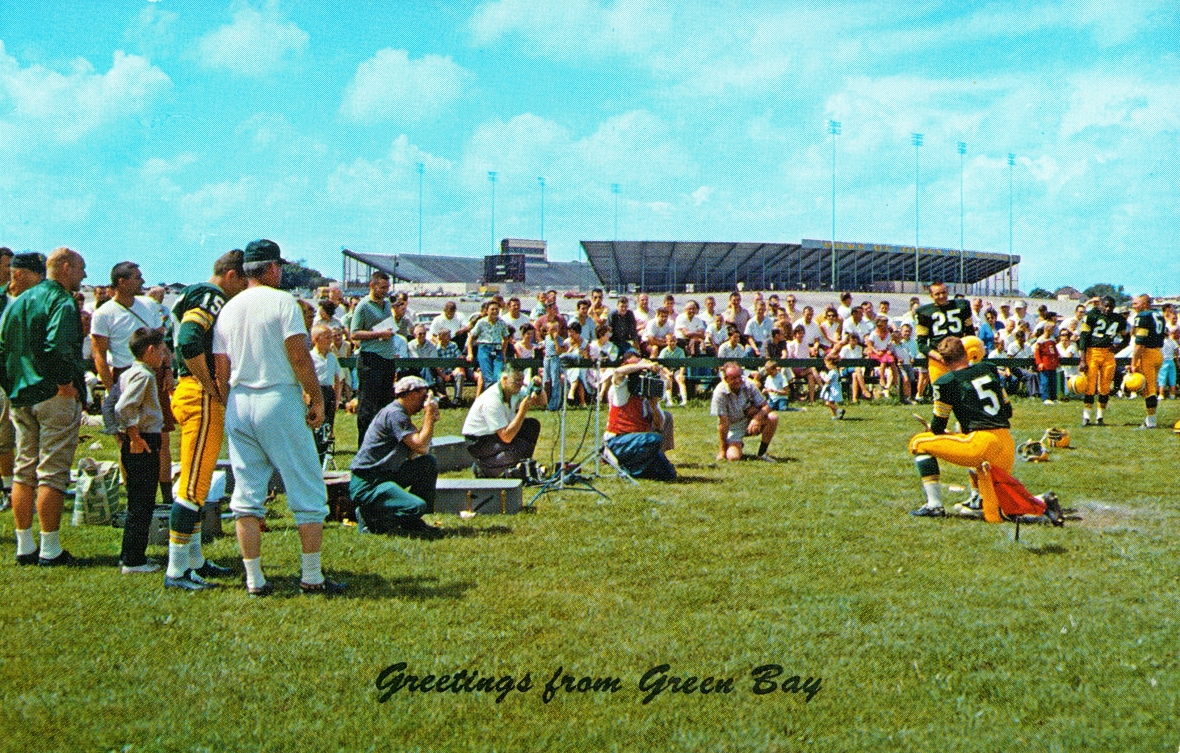
Since pro football did most of their photo sessions during training camp and it took up to a year for Post to plan and produce the artwork and, ultimately, the boxes on which the cards appeared, all of the 1962 Post football card photos were taken in the summer and fall of 1961.
The postcard photo shows Jim Laughead taking a picture of a kneeling Paul Hornung, the same position as used on Hornung’s 1962 Post cereal football card. 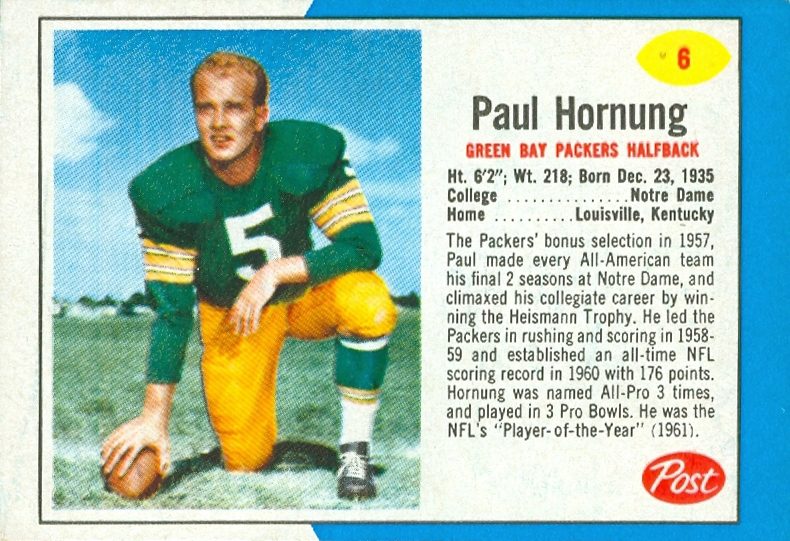 Why was Hornung kneeling? It sure didn’t look like this was a standard portrait shot as each of the three photographers was shooting simultaneously. There! A yellow helmet over Paul’s shoulder! And a pair of high top Converse directly below the helmet. It’s a kid! It looks like he’s in a football uniform getting his picture taken with Paul Hornung. What’s going on out there? The seed from the seed was now taking root.
Why was Hornung kneeling? It sure didn’t look like this was a standard portrait shot as each of the three photographers was shooting simultaneously. There! A yellow helmet over Paul’s shoulder! And a pair of high top Converse directly below the helmet. It’s a kid! It looks like he’s in a football uniform getting his picture taken with Paul Hornung. What’s going on out there? The seed from the seed was now taking root.
When my hunt for the red-vested Laughead had finished, there was still a desire to know how and why the kid had turned Hornung’s Post cereal photo from a “Huck’n’Buck” action shot to a rather pedestrian one knee picture. After all, Paul Hornung was literally the 1962 Post cereal promotion’s poster boy. He was featured in five commercials promoting the cereal trading cards, adorned two different advertising posters, was on the centerpiece of the grocery store aisle display, had his own booklet given away in stores teaching kids the “Fundamentals of Football,” had his likeness used in an ad on the back page of War-Stories Combat and Pinocchio comic books and urged kids on a Tang breakfast drink advertisement to “Get 14 National Football League Team Photos.” But nobody at the Packers photo shoot on Sunday, July 23, 1961 knew Hornung was going to be Post’s “Post-er Boy” the next year when cereal boxes with football cards on the back arrived in grocery stores in August 1962.
Paul Hornung won the 1956 Heisman Trophy as a senior at Notre Dame. Nicknamed “Golden Boy,” Hornung was drafted by the Green Bay Packers in 1957 and blossomed as a true triple threat—rushing, passing and kicking. He was money inside the 20 yard line and led the NFL in scoring from 1959 through 1961, recording 176 points in just 12 regular season games in 1960. Kids imagined being Paul Hornung. Madison Avenue recognized his advertising worth. General Foods, Post cereal’s parent company, had Hornung promoting anything that had to do with the 1962 football card promotion.
Huckin' 'n' Buckin'
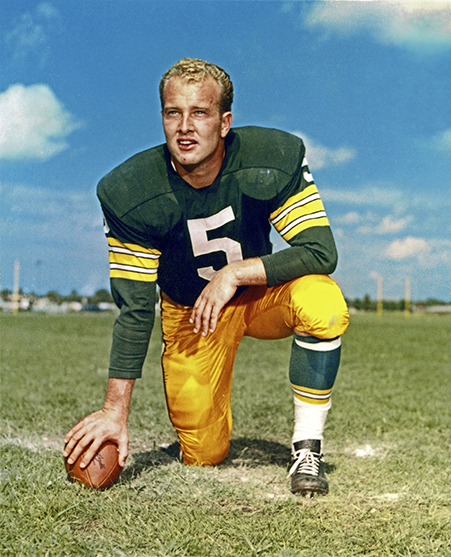 As a kid, I didn’t think a whole lot about why Hornung was kneeling instead of doing a posed action shot. That thought only occurred years later when getting back into football collecting. Sometime in the early 1960s I’d decided that gluing Hornung and Bart Starr Post cereal cards onto a homemade wooden plaque was a good idea. Then about 30 years later I decided it wasn’t a good idea and removed the glued cards from the plaque. Of course, that wasn’t a good idea either. I should have just left bad enough alone and kept intact a memory from childhood. But after starting to do some selling on eBay in 2000 and having a little extra cash, it was time to replace what I messed up years before. The 1962 Post cereal Hornung was the first eBay winner I experienced. Starr wasn’t too far behind as I wanted to know why the card I saw on eBay showed Bart in light yellow pants instead of the almost orange pants on my glued and removed card. Master set collecting was born for me that day. And…eventually I wanted to know why Hornung was kneeling instead of looking something like the photo shown here.
As a kid, I didn’t think a whole lot about why Hornung was kneeling instead of doing a posed action shot. That thought only occurred years later when getting back into football collecting. Sometime in the early 1960s I’d decided that gluing Hornung and Bart Starr Post cereal cards onto a homemade wooden plaque was a good idea. Then about 30 years later I decided it wasn’t a good idea and removed the glued cards from the plaque. Of course, that wasn’t a good idea either. I should have just left bad enough alone and kept intact a memory from childhood. But after starting to do some selling on eBay in 2000 and having a little extra cash, it was time to replace what I messed up years before. The 1962 Post cereal Hornung was the first eBay winner I experienced. Starr wasn’t too far behind as I wanted to know why the card I saw on eBay showed Bart in light yellow pants instead of the almost orange pants on my glued and removed card. Master set collecting was born for me that day. And…eventually I wanted to know why Hornung was kneeling instead of looking something like the photo shown here.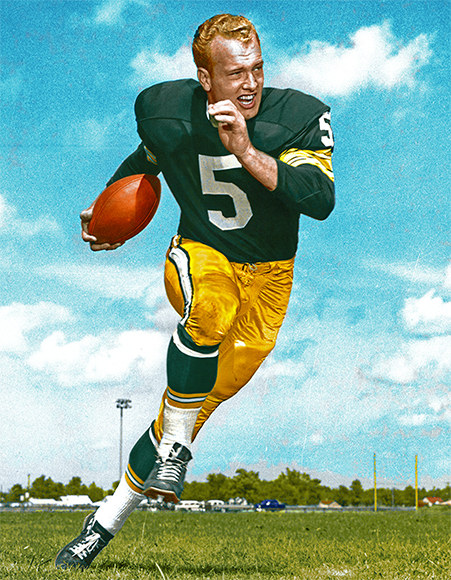
While searching for Laughead, many online newspapers were used. In the back of my mind I was keeping an eye out for another photo of Hornung and the kid. There were a few photos on various websites on the internet of Hornung and the kid but none listed the boy’s name. The images showed that the boy had an autograph book and Paul was signing for him. Who was this youngster that managed to get onto the field with Hornung, have quite a few photos taken with his hero including some by Jim Laughead and just maybe became the reason Hornung was kneeling? Was that why we didn't get an action shot on Hornung's Post cereal football card?
National Signing Day
I didn’t know where to take the investigation when, in 2017, Paul Hornung was going to be signing at the National Sports Collectors Convention in Rosemont, Illinois. You never know when you’ll have another chance so I packed up several Hornung Post cereal cards along with a photo of Paul with the kid from 1961. The plan was to show it to him and ask if he remembered the time when it was taken, hoping that he might say something like “Yeah. That was so-and-so’s kid” who was either a teammate or worked for the Packers in some capacity. Long shot? Sure, but what could he say worse than "no"?
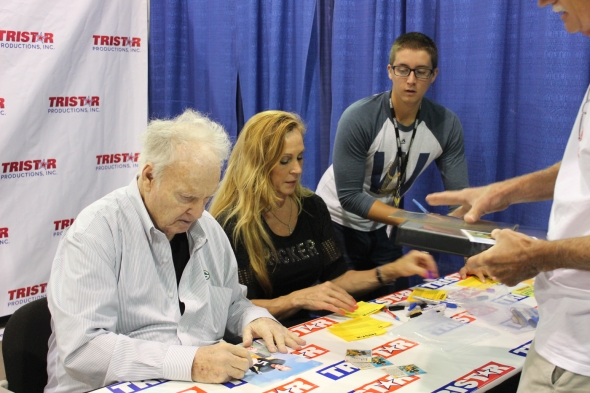 Signing day at the National came and I set my items to be signed in front of Paul. He was a signing machine and I knew there wouldn’t be much time. Immediately I showed the photo of Hornung and the kid to the lady with Paul at the signing table and asked her if Mr. Hornung might remember that event. While asking, she placed the photo in front of Paul Hornung.
Signing day at the National came and I set my items to be signed in front of Paul. He was a signing machine and I knew there wouldn’t be much time. Immediately I showed the photo of Hornung and the kid to the lady with Paul at the signing table and asked her if Mr. Hornung might remember that event. While asking, she placed the photo in front of Paul Hornung.
“No.”
Automatically he signed it. Okay, it wasn't what I hoped for.
Thank you, Dan Currie
It was nearly four years after the 2017 National. Paul Hornung passed away the previous fall. I usually have several Post cereal football projects going at once, one of which is digitally restoring all of the still existent original Post cereal production photos. In May of 2021 I had just finished up Dan Currie’s Post production photo and was going to e-mail a copy of the restored image to the owner of the photo. I wanted to comment that I wish Currie’s photo had more blue sky but it was cloudy when that photo was taken. About half of the Packers photos show sun and blue sky and the other half are dark and stormy looking. I’d previously noticed the two different skies in other photos taken at Green Bay Picture Day and decided to check whether it had rained in Green Bay on Sunday, July 23, 1961. Searching for the weather forecast in the Green Bay Press-Gazette of July 23rd produced no results. What? No Sunday paper? That’s odd. Maybe the paper on the 24th will say something about the weather for the previous day. That day's online edition did exist but I couldn’t find the weather indexed on the front page. After perusing a few pages, I decided to go to the sports page just to see what was there. A photo of Packers defensive back John Symank with his twin daughters was in the upper left corner of the sports page and just below were four Packers wives taking in Green Bay Picture Day. To the right was a photo of—you’ve got to be kidding!—Hornung and the kid. Preparing for the disappointment I was sure to come, I sat amazed that the caption gave the name I had been searching for so long.
Mark Bartell. Mark Bartell. Mark Bartell!!! That's the kids name!
Oh, and there was a short write up that said there was a storm on photo day that had delayed the photo shoot. Two for one. First thought was “how could you have been so dumb as to not search the Press-Gazette the day after the photo shoot before this?” It was right there all along. Forget that. Time to find Mark Bartell.
Finding Mark Bartell
The boy in the photo with Hornung looked to be a maximum of ten years old and, stretching the minimum a bit, five. That would make him 65-70 in 2021. Google found a guy named Mark Bartell who lived in the Milwaukee, Wisconsin area that was in the right age range. I wrote a letter explaining why I was contacting him and included photos of Paul Hornung and Mark Bartell on Green Bay Picture Day in 1961. Near the end of May, my SASE came back. “Sorry, I’m not the person you are looking for.” Well, he was the only Mark Bartell in Wisconsin that fit the criteria. This search was going to require a more diligent approach.
Going back to the online newspapers, there was another Mark Bartell who would have been around 16 in 1969 near the Green Bay area. His father’s name was given in one article. Soon, Mark’s father’s obituary was located and Mark's city of residence was given. Google again found an address for Mark Bartell in the same city as the obituary listed and another letter and set of photos was dispatched. The letter arrived at Mark’s home on June 6th. I believed I had the correct Mark Bartell but had not heard anything back by the 4th of July. Maybe this wasn’t going to happen.
Sunday July 11th brought an e-mail saying “Yes, I am the young boy in the photo.” Mark promised that he would review his scrapbooks and write back about his recollections soon. Mark’s next e-mail arrived a few weeks later…
“Your letter certainly stirred memories and the more I reminisced, the more I remembered. I have attached some pictures (see description below) and an essay on my experience with Mr. Hornung. I must credit my mom for cutting these pictures from various newspapers and posting them in my scrapbook. At the time, I wasn’t that interested in these pictures and slightly embarrassed by the notoriety, so if left to me, I may not have collected any. While it doesn’t surprise me, I never knew there were Post cereal football card collectors. Growing up, we were a Kellogg’s family, so I don’t believe I had seen that Post cereal Hornung card.”
Included with Mark’s e-mail were several scans of photos and an essay he wrote about his experience at Green Bay Picture Day in 1961.
A Green Bay Packer Fan: My Early Years by Mark Bartell
I was born in Green Bay, Wisconsin in 1953, which meant my childhood was entwined with the great Lombardi-era Packer teams. Growing up in Green Bay meant you bled Green and Gold and almost every young boy had dreams of playing for the Packers; I was no exception. My chums and I would pretend to be our favorite player whenever we gathered at the neighborhood vacant lot to throw wobbly passes or dash through phantom defenses onward to victory. My favorite Green Bay Packer was Paul Hornung – the NFL’s Golden Boy.
In those days, it was said, Green Bay was known for two things: toilet paper and the Packers. The paper mills of Charmin, Northern, and Fort Howard had afforded three uncles, a couple of friends’ fathers, and a neighbor or two a good living. The Packers provided a year-round diversion that kept the adults entertained and animated many a boyhood daydream.
In the summer of 1961, I received a Packer football uniform complete with helmet, pads, jersey, and pants for my eighth birthday. My parents purchased this from Denis Sporting Goods on East Main Street. There was no “G” on the helmet because the Packer organization wouldn’t officially unveil their new logo until August 5 of that year1, and no numbers on the out-of-the-box jersey, so my mom stitched the numeral “5” on the front and back and shoulders of the green jersey. Having worn my gear for a couple of weeks around the house and at a handful of practice sessions with my friends, I was excited when my dad asked me if I wanted to attend the annual Packer Picture Day in uniform. Of course, the answer was yes – I was quite proud of my uniform. This was back when Packer memorabilia consisted of player cards, team pennants, and a rather generic looking bobble-headed figurine. A Packer uniform with a numbered jersey was indeed unique. So, on Sunday afternoon on July 23rd, my dad and I joined the hundreds of spectators lining the practice field to watch the Green Bay Packers in a photo session. Before we left our house, my mom suggested that I borrow my older sister’s autograph book, just in case I was lucky enough to talk to a Packer.
I lived one and a half miles from the new City Stadium (present day Lambeau Field). The Packer practice field was east of the stadium across South Oneida Street and adjacent to the Brown County Arena. Today, this practice area is comprised of Clarke Hinkle Field, The Don Hutson Center, and Ray Nitschke Field. In the early 1960’s, the open-air practice field took up an entire city block. A small set of bleachers lined a portion of the field parallel to Oneida Street and a wooden fence, more like a railing, provided some separation of the public area and the practice turf. As we mingled with the crowds, I inched my way toward the railing to improve my view and leverage an eight-year-old’s height. The Packer players were having pictures taken in various action poses that would eventually fill game day programs, sports magazines, newspapers and, what I would later learn, Post cereal collector cards. Several of the Packers had their wives and kids in attendance, so the day was a real family affair.
My first memory of being spotted was of a couple of Packers chuckling to themselves and pointing in my direction. Max McGee, number 85, shouted in number 5’s direction that there was another Hornung on the field. Before I could grasp the situation, my dad and I were invited onto the practice field and into a group of players and coaches. My hero, Paul Hornung, walked over and greeted me.
“Why don’t you two pose for a picture together?” someone said. “Sure,” said Hornung, shaking hands with the boy. “Come on. How ‘bout a little smile now?” The boy smiled, and a photographer snapped the picture.2
The following year, 1962, sportswriter Dick Schaap published a brief biography of Paul Hornung with a small section of one page mentioning my verbal exchange with Mr. Hornung. My recollection is that Mr. Hornung said hello and asked my name as he shook my hand. I was awestruck but I did ask for an autograph which he graciously provided, then he knelt as we posed for pictures. Of the seven different photos I have seen, Mr. Hornung started on his right knee then switched to his left knee, culminating with me sitting on his right thigh. I believe the last picture taken of us was the one from my dad’s camera.
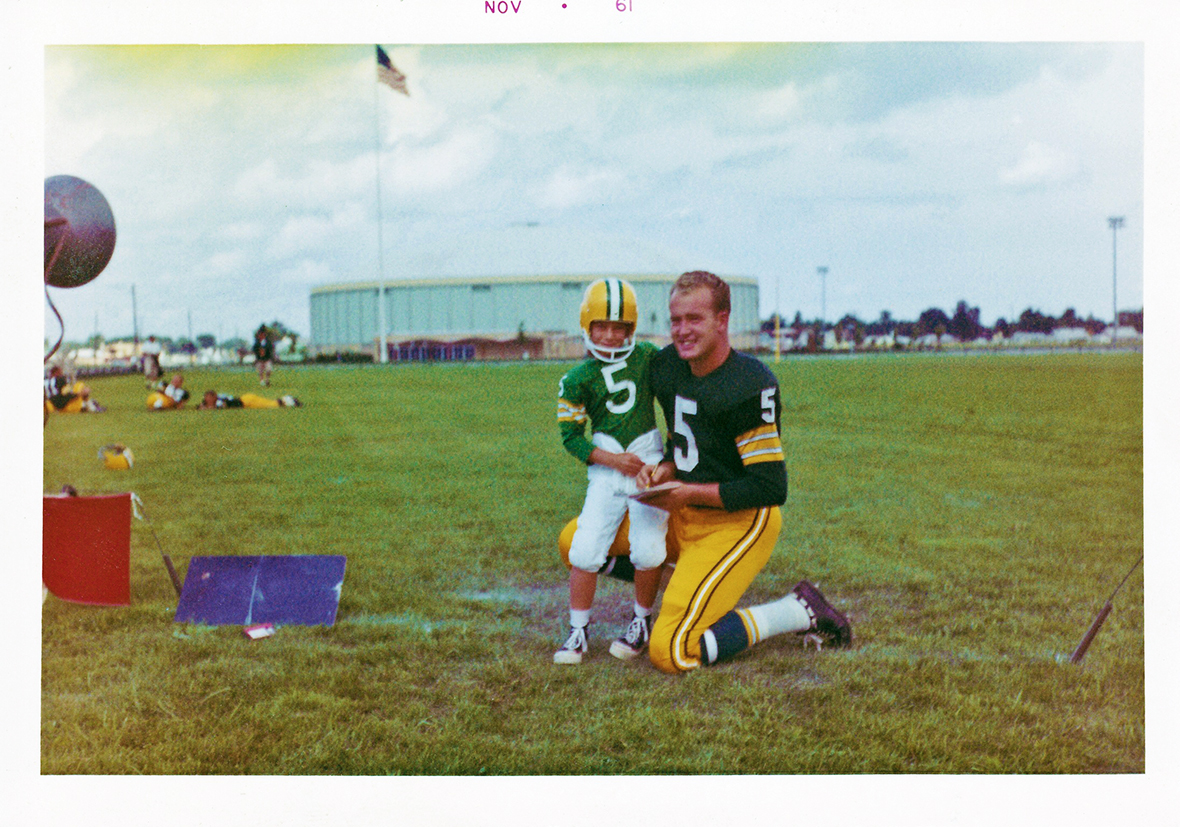
The atmosphere on the field was relaxed and loose, but the players and photographers eventually turned their attention to the business at hand. My dad and I stayed on the field, and I was able to secure a few more Packer signatures: Vince Lombardi, Jim Taylor, Max McGee, Ron Kramer, Lew Carpenter, Bart Starr, Bill Quinlan, Willie Wood, and Ray Nitschke. When I got back home, I returned the autograph book to my sister but only after carefully removing the pages that held my treasure and posted them in a scrapbook. 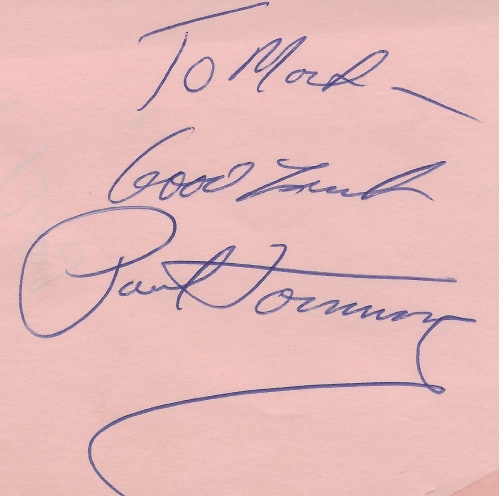
Green Bay was a small town and seeing Packer players out-and-about was a common occurrence. Many of the players made Green Bay their home throughout the year, not just during football season. I attended Saint Agnes Catholic School (Holy Family, today) and was a Cub Scout then later a Boy Scout in the school’s Pack and Troop. On more than a few occasions, we had Packer players speak at Scout father-son banquets; Bart Starr was one of those players. Mr. Starr had a home near our school and, although not a Catholic, he was a supporter of scouting. I still have an autograph from that dinner. Jim Ringo (51), the All-Pro center for the Pack, and his family rented a house across the street from my grandparents on Bond Street. While tagging along with my folks to the local A&P supermarket, we would occasionally run into Fuzzy Thurston (63) and his wife grocery shopping, too. What a town. Oh, and during the regular season of 1961, three Packers rented a home at 1029 South Fisk Street which was around the corner and about one block from my house. Those Packers? Jesse Whittenton (47), Ron Kramer (88), and Paul Hornung.
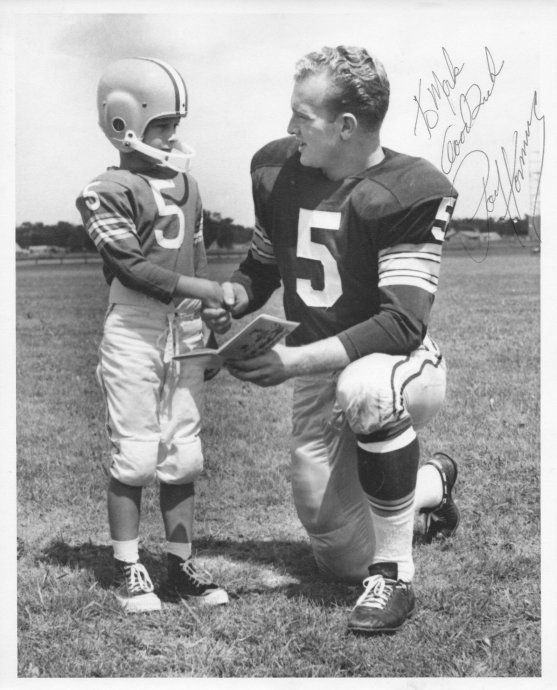 I believe it was in late September that my dad requested two copies of black and white 8x10 photos of Mr. Hornung and myself from the Green Bay Press-Gazette newspaper office. With the pictures in hand, my mom walked me up to Mr. Hornung’s home, I rang the doorbell, he opened the door, and I introduced myself and asked if he would sign the pictures. Mr. Hornung smiled and remembered that I was the boy from Picture Day. I said, “Thanks a lot, sir.” I waved and walked back toward my mom. Just imagine doing that today with a football star of Mr. Hornung’s caliber – you might not get past the gate or guard shack.
I believe it was in late September that my dad requested two copies of black and white 8x10 photos of Mr. Hornung and myself from the Green Bay Press-Gazette newspaper office. With the pictures in hand, my mom walked me up to Mr. Hornung’s home, I rang the doorbell, he opened the door, and I introduced myself and asked if he would sign the pictures. Mr. Hornung smiled and remembered that I was the boy from Picture Day. I said, “Thanks a lot, sir.” I waved and walked back toward my mom. Just imagine doing that today with a football star of Mr. Hornung’s caliber – you might not get past the gate or guard shack.
My life wasn’t the only one entwined with the Packers. My father worked for Wisconsin Bell Telephone; however, during the Packer football season, he was employed part-time, like some of Green Bay’s fortunate fans, by the Packer organization. My dad began as an usher and ticket taker when the new City Stadium opened in 1957 and progressed through different jobs and responsibilities until he retired from the organization after the 1995 season. In 1961, his job was to help supervise the placement of first-aid equipment and personnel inside the stadium on game days and to make sure that wheelchair-bound fans would be safely escorted down the stadium’s north side ramp, then onto the field along the Packer sidelines.
1961 became a significant year in my early life. I began to tag along with my dad to Packer home games. For reasons that are lost to time, I was able to enter the stadium with my dad. We would arrive three hours before kickoff and I was permitted to roam inside the stadium, not on the field or in the stands but under the stands where the concession vendors were setting up, and then watch the game standing in the wings. The policemen and stadium ushers must have known my dad because my presence was never questioned. I even attended the NFL Championship Game against the New York Giants on New Year’s Eve in what I remember to be the beginning of Green Bay’s nickname: Title Town USA.
If you have seen early pictures of the new City Stadium, you will notice that it was quite small by comparison to the current Lambeau Field; it held 32,132 paying customers3. Although bleachers ringed the stadium, the north and south ends were somewhat open-ended. The home and away team locker rooms were located at the south end. At game time, I would position myself near the north side ramp along the back of the bleachers to watch the game. As the stadium grew larger, more bleachers were added and the Packer offices with locker rooms were built on the north end of the stadium; this limited any standing room for nonessential persons. My dad was able to get me onto the field where I would sit on the rain tarps that were rolled-up on culvert pipes along the sidelines – always on the away team’s sideline because Mr. Lombardi did not like any nonessential personnel on the Packer sidelines. I did this for every home game until I was old enough to become a hot dog vendor at the age of fourteen. HOT DOGS, get your hot dogs here! Now that brings back some memories.
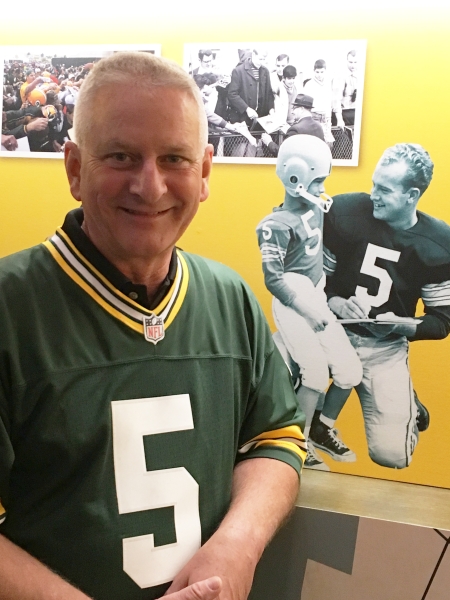 I persisted as a stadium vendor until I graduated from high school. I continued to play football even as I outgrew my first uniform. Although my football “career” was limited to playing on a junior varsity team through my sophomore year in high school, my interest in football and the Packers never waned. Attending Packer games became a rarity once I moved from Wisconsin, but I continued to tag along with my dad whenever my visits back home coincided with game days. Every now and then, that photo of Paul Hornung and me pops-up on my radar, as is the case with your curiosity in the details behind the Post collector card. Five years ago, I toured the Packer Hall of Fame at Lambeau Field. As I read the placards and viewed the exhibits, I rounded a corner and found myself in the Community Gallery; on the wall was a picture of me with Paul Hornung. 1961 was an incredibly good year.
I persisted as a stadium vendor until I graduated from high school. I continued to play football even as I outgrew my first uniform. Although my football “career” was limited to playing on a junior varsity team through my sophomore year in high school, my interest in football and the Packers never waned. Attending Packer games became a rarity once I moved from Wisconsin, but I continued to tag along with my dad whenever my visits back home coincided with game days. Every now and then, that photo of Paul Hornung and me pops-up on my radar, as is the case with your curiosity in the details behind the Post collector card. Five years ago, I toured the Packer Hall of Fame at Lambeau Field. As I read the placards and viewed the exhibits, I rounded a corner and found myself in the Community Gallery; on the wall was a picture of me with Paul Hornung. 1961 was an incredibly good year.
Cliff Christl (August 20, 2020) Packers Training Camp Memory: The Unveiling of the ‘G’. Retrieved from
https://www.packers.com/news/packers-training-camp-memory-the-unveiling-of-the-g
Dick Schaap, Paul Hornung: Pro Football Golden Boy, Sport Magazine Library Number 13 (Macfadden-Bartell, New York, 1962), p. 103.
Neil MacKay, Milwaukee Journal (September 30, 1957) September 29, 1957: The Birth of Lambeau Field. Retrieved from http://archive.jsonline.com/sports/packers/181932681.html
Mark Bartell at The Ice Bowl
In an aside away from the main topic, curiosity got the better of me, wondering if Mark had been at the December 31, 1967 NFL Championship game played at a temperature of -13° F, better known today as The Ice Bowl.
"My first season as a hot dog vendor was 1967. The section I worked was the northeast portion of the stadium near the 20-yard line, if I remember correctly. The Packers were defending Super Bowl champions and had clawed their way to, again, meet the Dallas Cowboys in the NFL Championship game. New Year’s Eve and a frigid winter’s day where the sun added no warmth whatsoever, gave birth to Lambeau Field’s frozen tundra legend. It was dismal weather to sell hot dogs because no one wanted to remove their hands from their gloves. I recall loading my Styrofoam chest with aluminum foil-wrapped hot dogs, slinging the strap around my neck and barking out “hot dogs, get your hot dogs here”. My feet were cold, my hands were cold, even the hot dogs struggled to stay warm. I only sold two that game."
Picture Day Notes
Mark's dad, Bob, was pictured in the Green Bay Picture Day postcard near the left side.
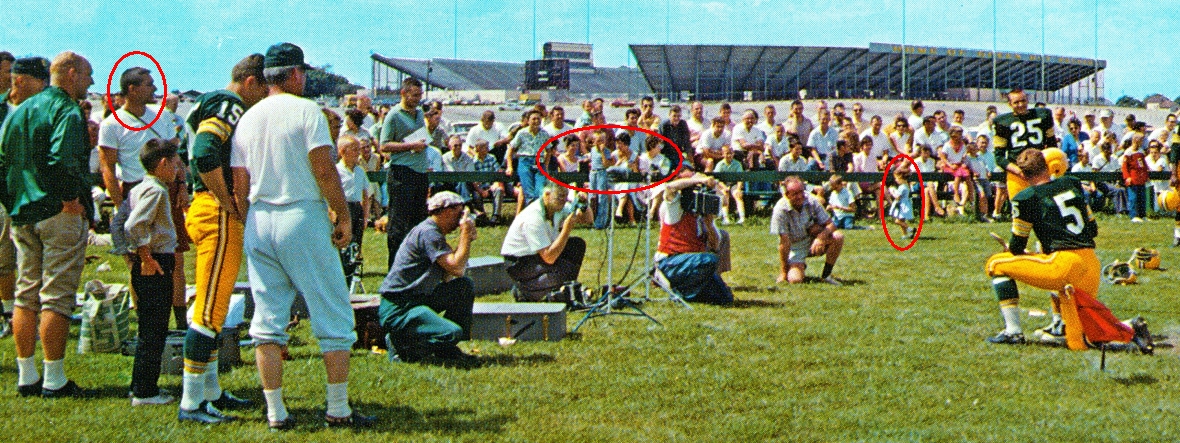
The ladies outlined in red behind the rail included Packers' wives Jackie Nitschke, Pat Dowler, Sarah Symank and Ann Forester. The little girl in the light colored dress appears to be one of John Symank's twin daughters.
What was Vince Lombardi doing during the photo shoot? Mark remembered it this way: "Looking at the “Greetings from Green Bay” postcard, Mr. Lombardi was among a group of coaches and players that were to the left of where my dad was standing – just out of view. Mr. Lombardi was dressed like the two coaches on the left of the postcard: green windbreaker, white tee shirt, khaki knee length pants, and a ball cap. I remember the relaxed atmosphere and many smiles, including the head coach’s as he signed my autograph book; he and my dad spoke briefly."
Photographers at Green Bay Picture Day
The official photographer was Jim Laughead, accompanied by his son-in-law and business partner, "Brad" Bradley. Vernon Biever, a member of the Packers Hall of Fame who photographed the team for 66 years was present. A photo of Hornung and Mark Bartell that credited Biever ran in the August 6, 1961 Milwaukee Journal. Vernon is not noticeably visible in the Green Bay Picture Day postcard, but directly behind Laughead's hat is the top of what could be Mr. Biever's head and to Laughead's left is a pant leg and shadow. This guess is based on the angle of the background of the photograph Vernon took of Hornung and Bartell. The photographer to the left of Laughead in the Green Bay Picture Day photo, again based on background positioning, was with the Green Bay Press-Gazette. Jeff Ash, with the Press-Gazette, was contacted in 2013 and provided the names of 1960s Press-Gazette photographers Emery Kroening, Orvell Peterson, Russ Kriwanek and Ken Behrend. A guess from here based on ages in 1961 is that the Press-Gazette photographer that day was Kroening or Peterson, with a lean toward Kroening. The left most photographer in the flat cap wearing blue should have been the man from Topps. It is not known who the man to the right of Laughead holding the football was. He does not look like Brad Bradley. In fact, no one in the photo appears to be Bradley although he should have been present.
In the black and white photo below, Vernon Biever is outlined. The two photographers just right of Laughead are unidentified.
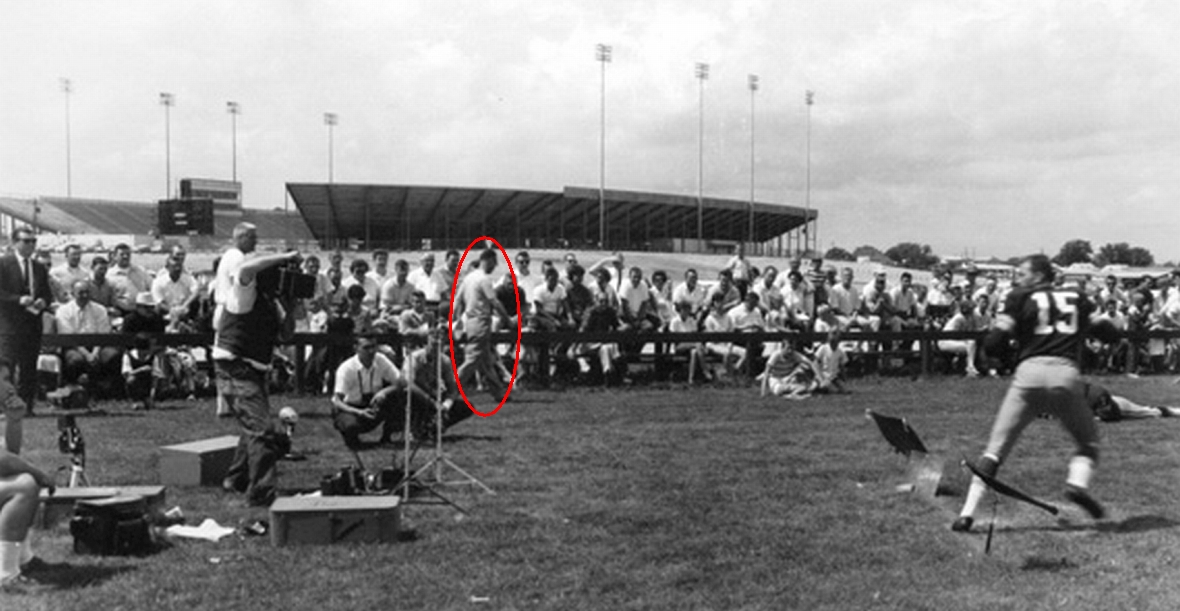
Why did Post use the kneeling photo?
When Jim Laughead did photo shoots for NFL teams, he used more black and white film than color. In the early 1960s, color film was still reasonably more expensive than black and white. In addition, the vast majority of Laughead's photos were used in newspapers and magazines, more often than not these were black and white publications. So Laughead took mainly monochromatic pictures.
Laughead's assignment for Post required color film for their rotogravure printed football cards. Any photographer in business would have been as conservative as possible with expensive film. When Mark Bartell was brought onto the field, did Jim Laughead keep firing with the color camera? Maybe he used up an extra shot or two that limited the number of color action shots he took of Hornung later. Whether that happened or not remains a secret in Brad Bradley's file of negatives. In any event, it appears that Laughead liked the kneeling pose of Hornung because he shot at least one more of Paul after Mark Bartell exited the shooting area.
Shown here are Hornung's 1962 Salada Tea—Junket Desserts coin on the left and a photo from the cover of the 1963 Sports Review Pro Football. As noted on the Panel Man page under the Photographer menu, Jim Laughead was also the 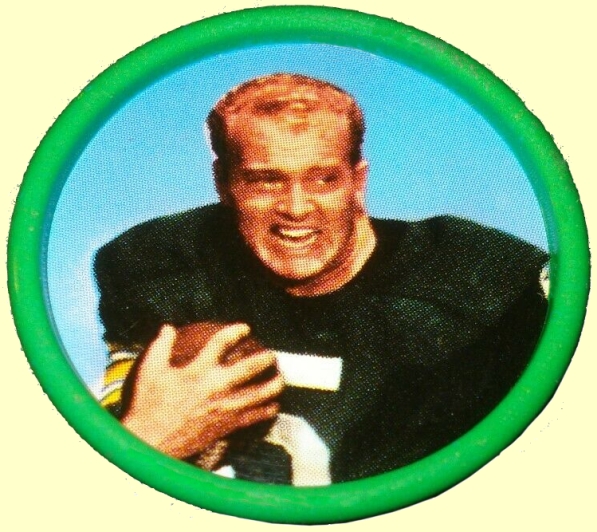
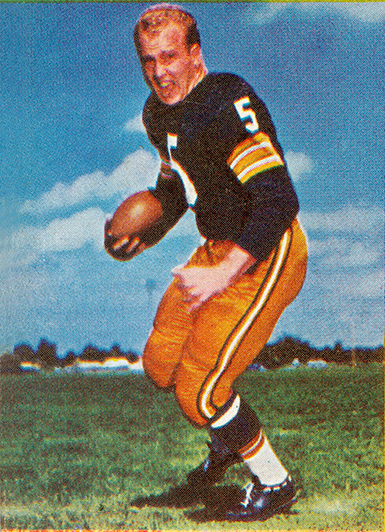 photographer of the images used on the Salada coins as prints not used in the Post set were used in Salada's. The Salada and SRPF images of Hornung show that action shots were available. Sixty years later, it can only be speculated that Post had the option over Salada as to which photo of Hornung they preferred. This is based on the thought that Post paid $50,000 to the NFL players' pension fund for use of photos while Salada paid Laughead $25 each for images used on their coins. One would think Post would have priority in photo choice based on those numbers. Additionally, Salada used photos of only 11 of the 14 NFL teams in their set, skipping the Minnesota Vikings, St. Louis Cardinals and Dallas Cowboys and replacing them with the AFL's Boston Patriots, New York Titans and Buffalo Bills. There is a decent probability that there were issues with having enough photos of the Vikings, Cardinals and Cowboys to fill the Salada team requirements aiding the conclusion that Salada got second choice. Possibly the Hornung action shots on the Salada coin and SRPF cover were the best available and Post chose the more stately looking kneeling shot for the image of their Post-er Boy.
photographer of the images used on the Salada coins as prints not used in the Post set were used in Salada's. The Salada and SRPF images of Hornung show that action shots were available. Sixty years later, it can only be speculated that Post had the option over Salada as to which photo of Hornung they preferred. This is based on the thought that Post paid $50,000 to the NFL players' pension fund for use of photos while Salada paid Laughead $25 each for images used on their coins. One would think Post would have priority in photo choice based on those numbers. Additionally, Salada used photos of only 11 of the 14 NFL teams in their set, skipping the Minnesota Vikings, St. Louis Cardinals and Dallas Cowboys and replacing them with the AFL's Boston Patriots, New York Titans and Buffalo Bills. There is a decent probability that there were issues with having enough photos of the Vikings, Cardinals and Cowboys to fill the Salada team requirements aiding the conclusion that Salada got second choice. Possibly the Hornung action shots on the Salada coin and SRPF cover were the best available and Post chose the more stately looking kneeling shot for the image of their Post-er Boy.
It is also possible that Jim Laughead made the choices and simply sent one proof of each player to Post and thus Laughead himself was the reason for the kneeling shot of Hornung that was used. There were portrait-style shots of seven players out of the 200 used in the Post set. One could conclude that in at least these instances, good images were at a premium. The same could be true of Y. A. Tittle's kneeling image and ultimately Hornung's.
Whatever the reason that Post chose to use Hornung in the kneeling position, Hornung likely got in that position only because there was a second number 5 in the crowd at Green Bay Picture Day July 23, 1961. Mark Bartell became the recipient of a young boy's thrill of a lifetime. Though Mark never knew it, the whole look of the 1962 Post football promotion was changed because he had a recent birthday and had the opportunity to get an autograph of his Packer hero.
One thing was intentionally omitted from the story about Hornung signing at the 2017 National until now. When Hornung's female aid looked at the photo of Paul and Mark Bartell, she asked if I was that boy. Chuckling, I replied, "No. But I wish I was." Don't we all! Beautiful memory, Mark! Thanks for sharing your story!

